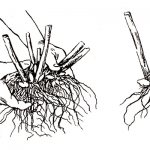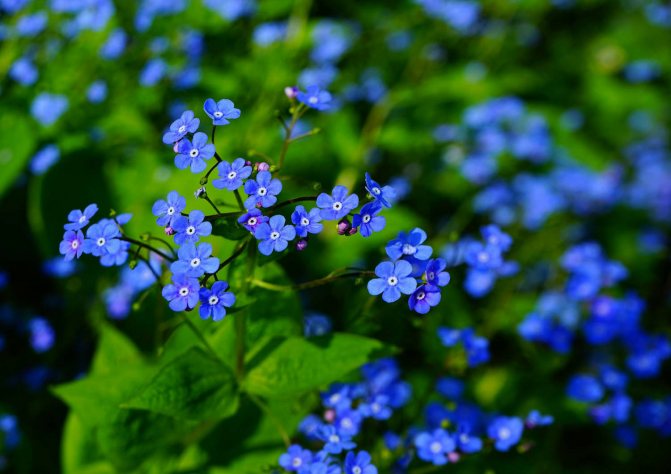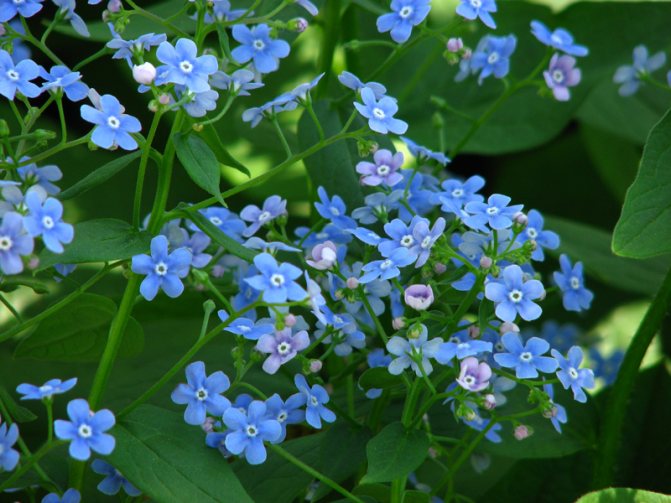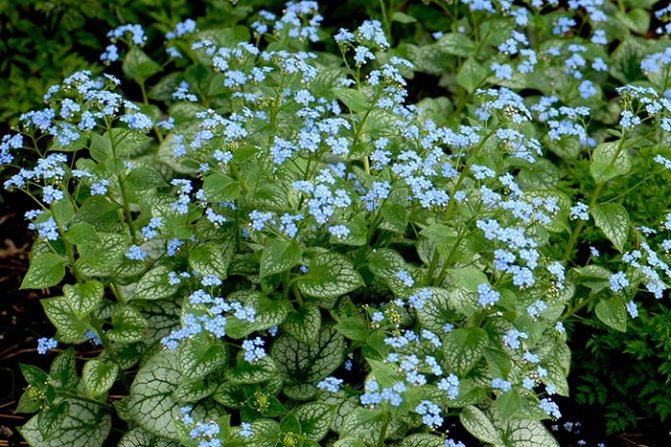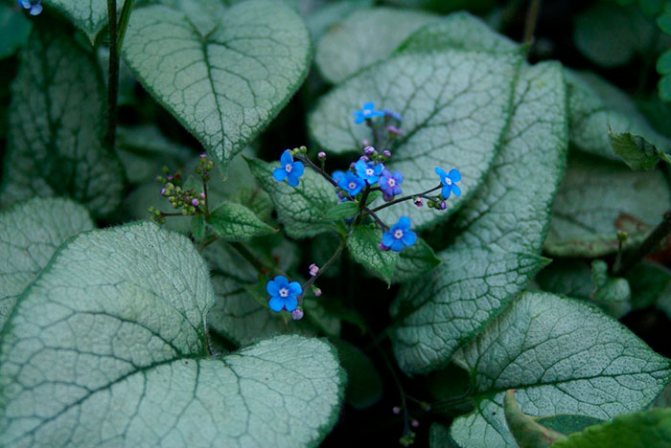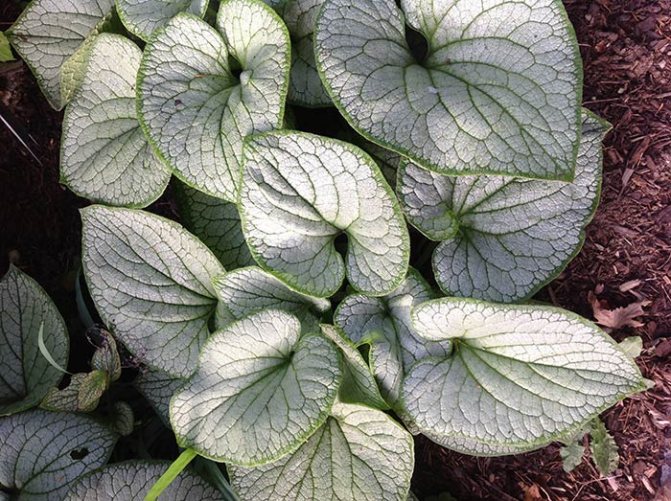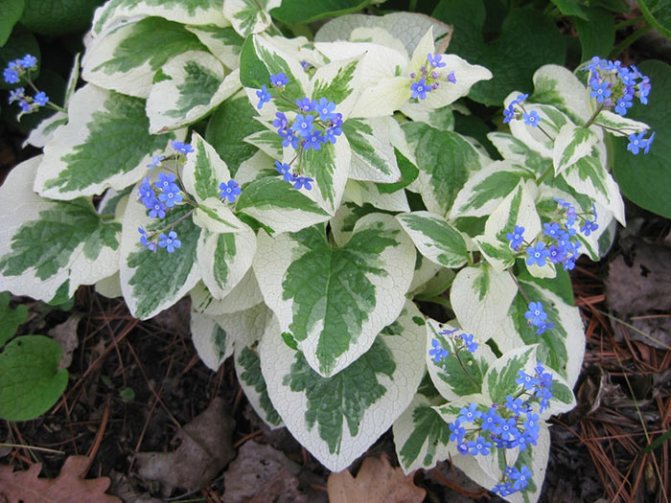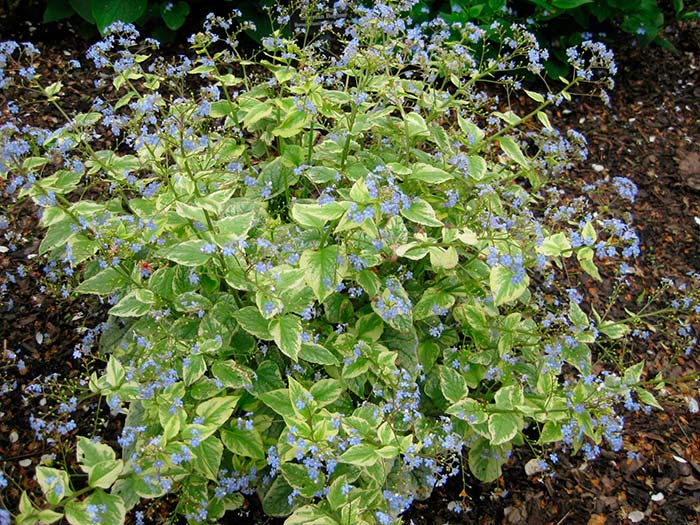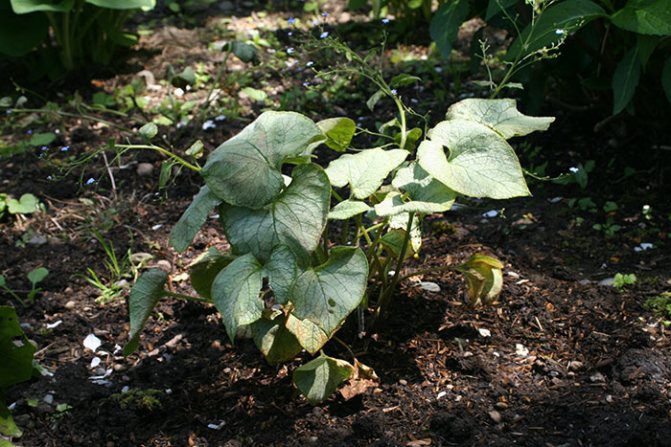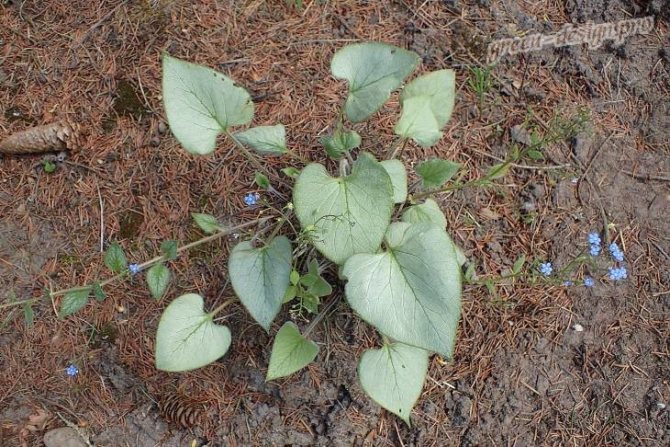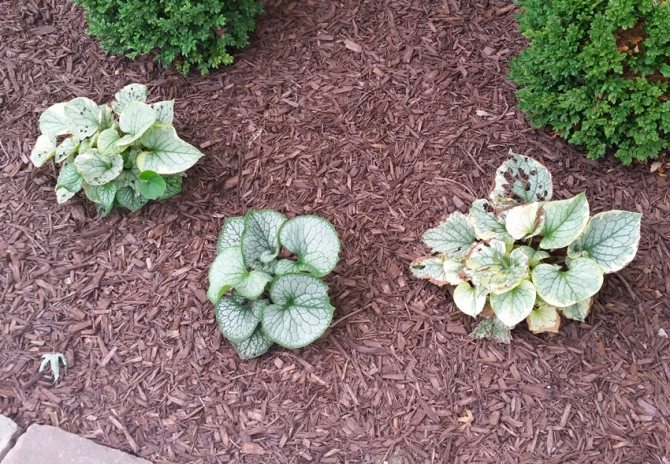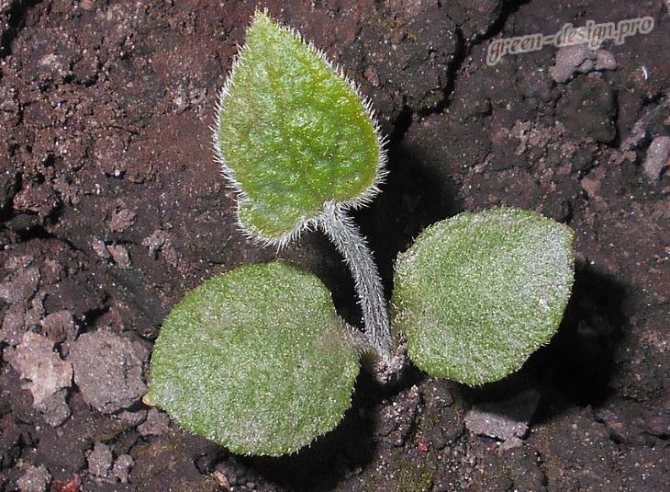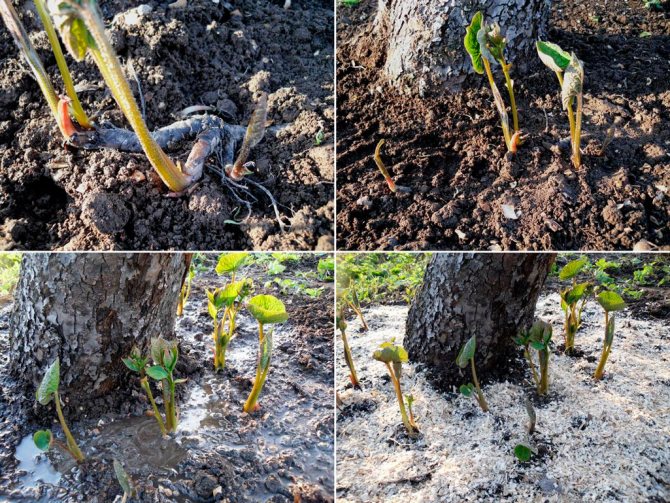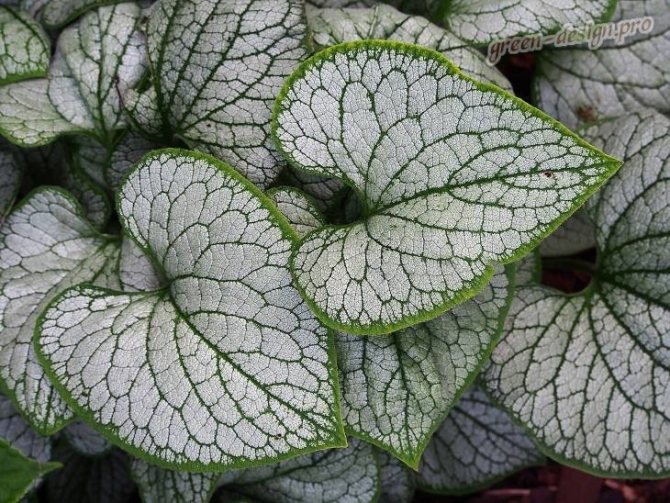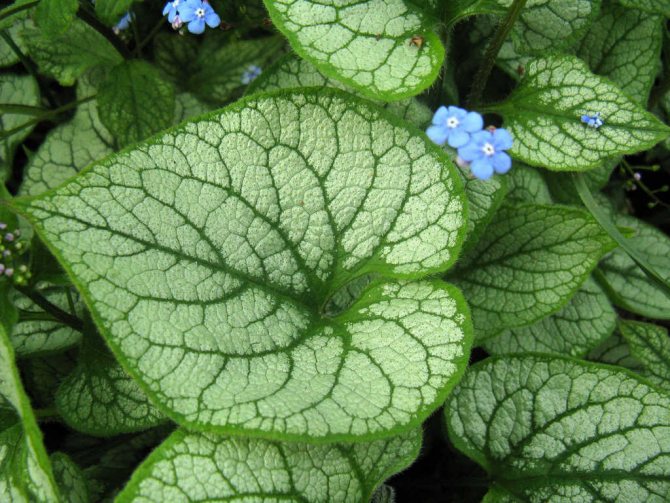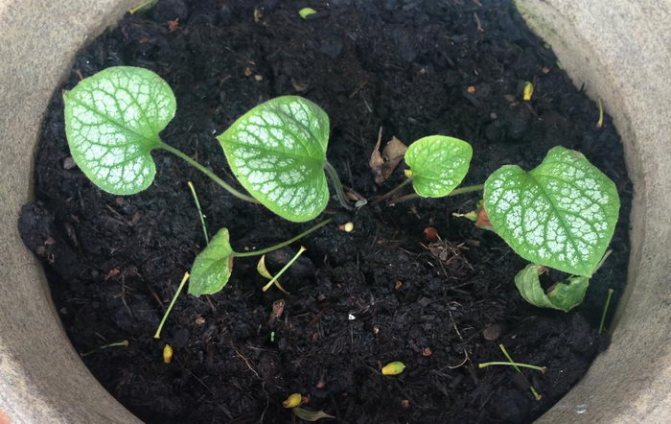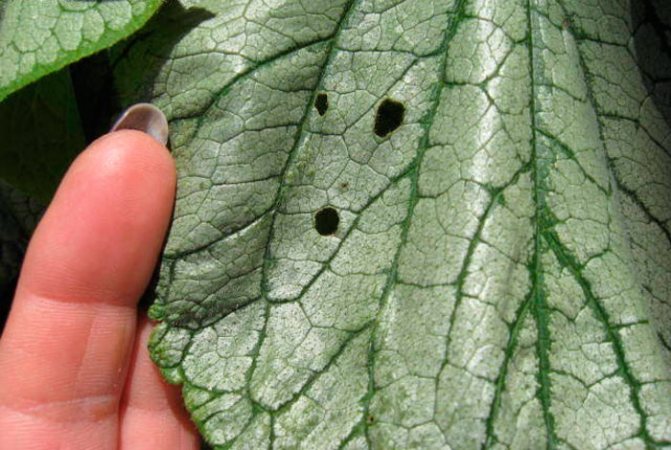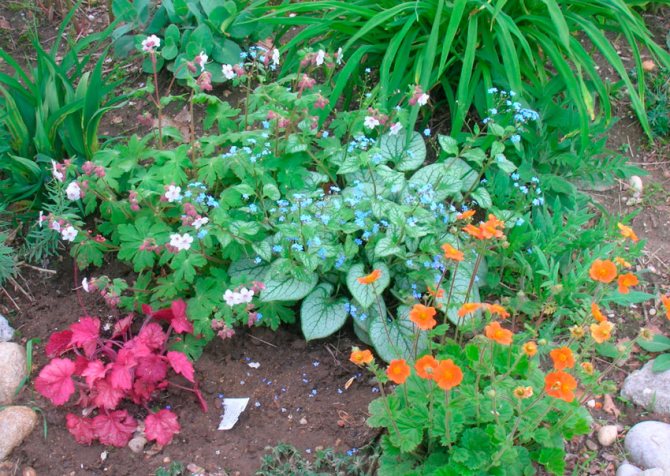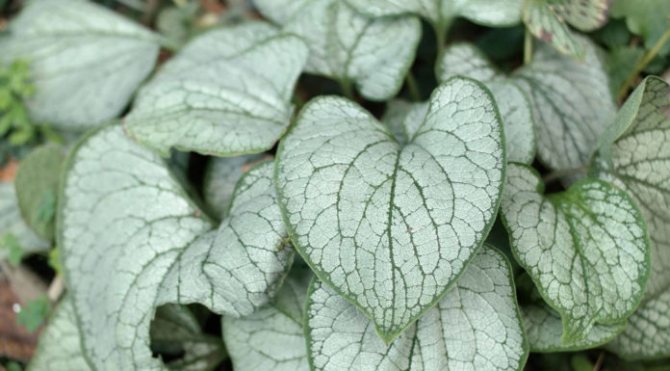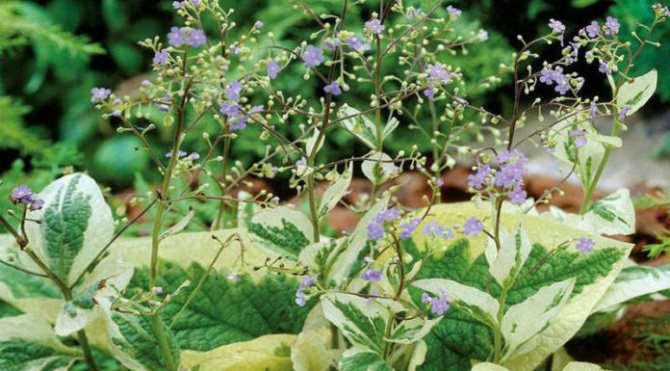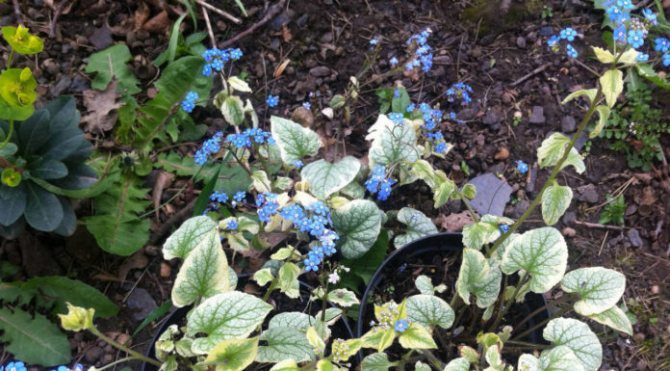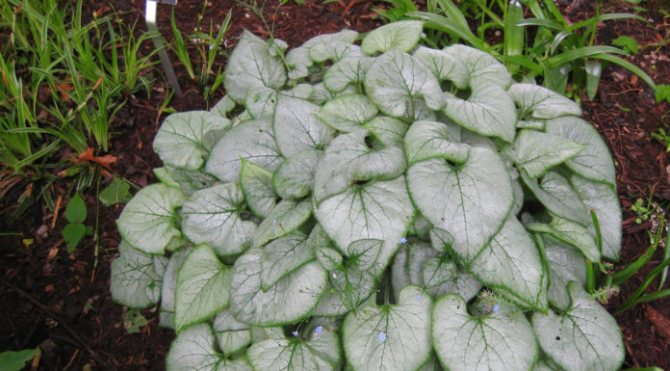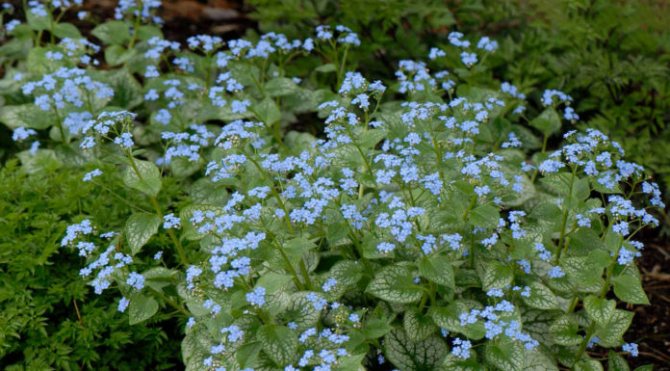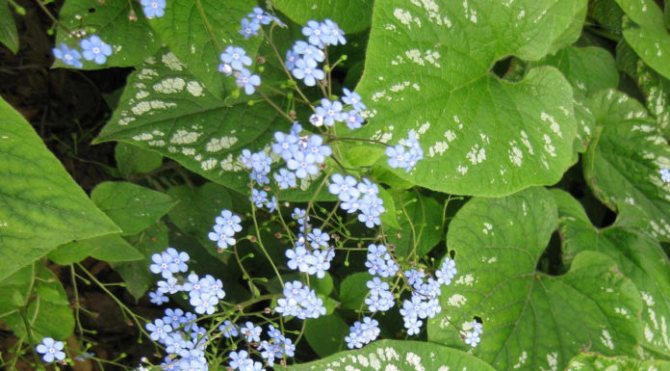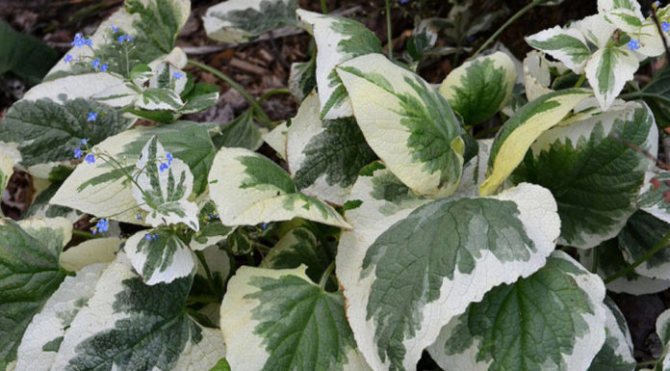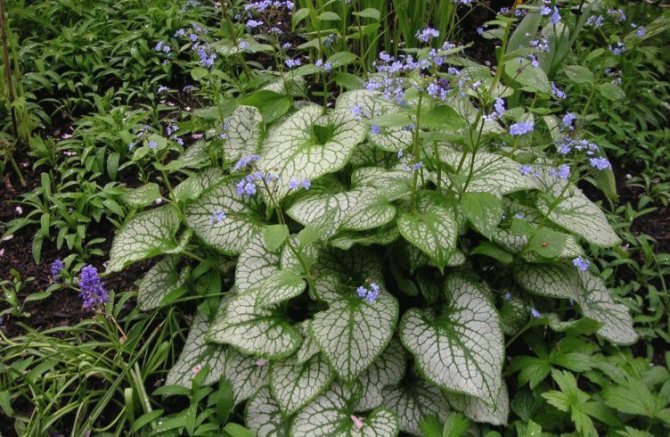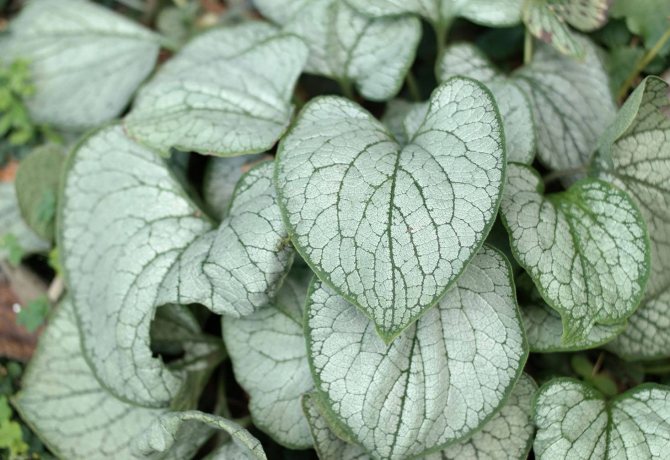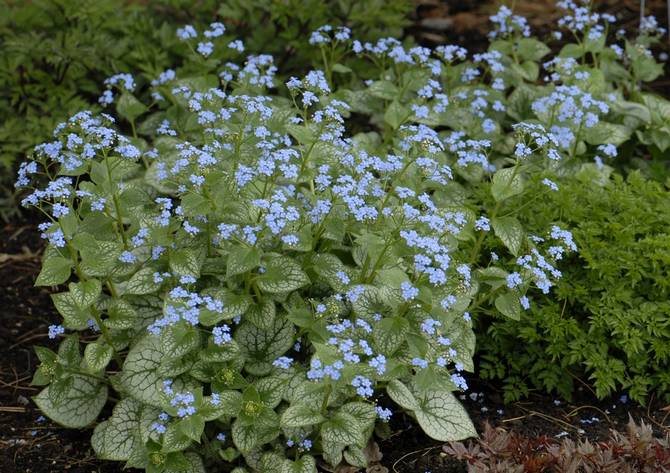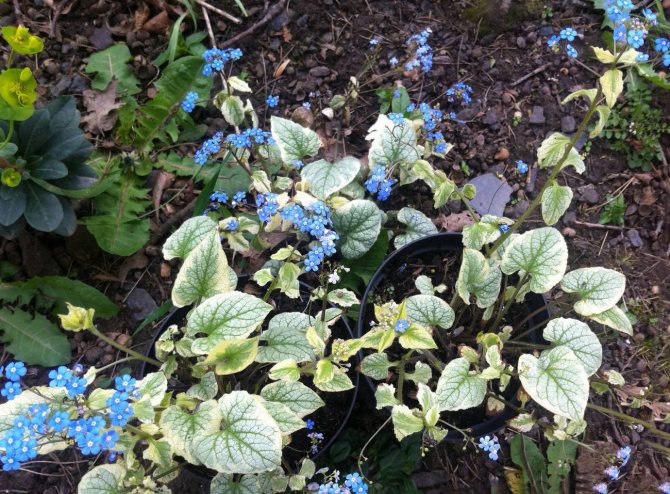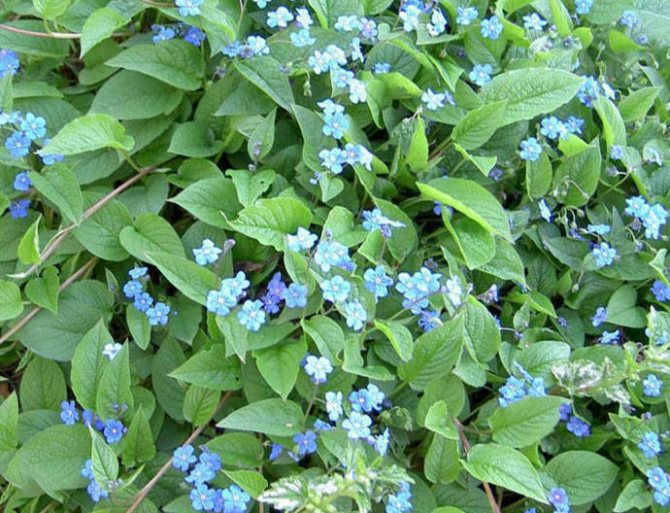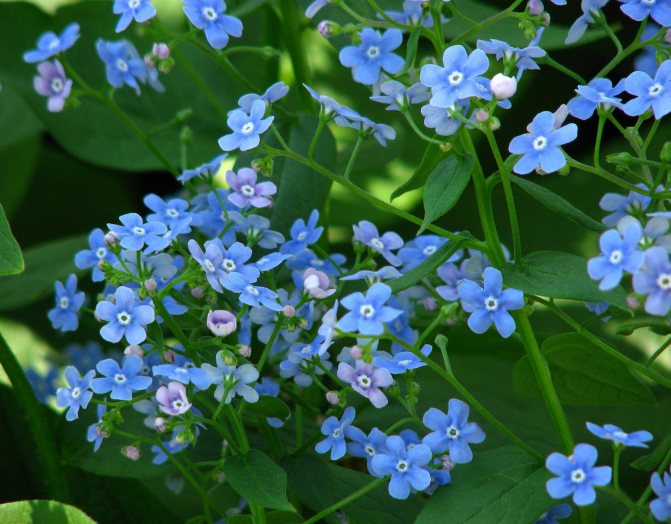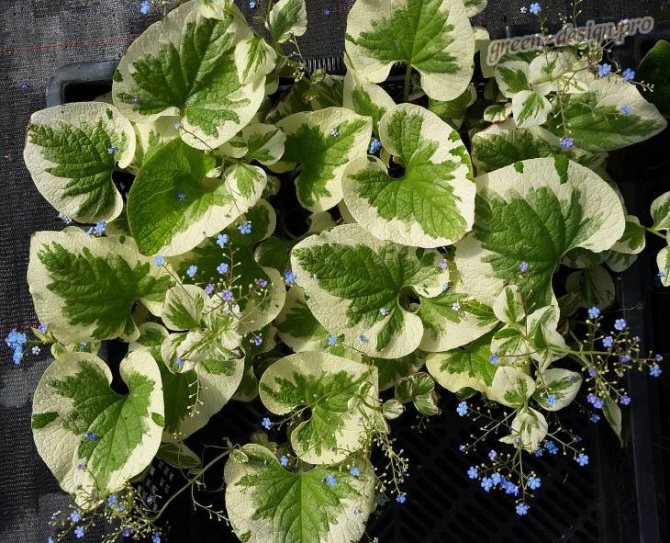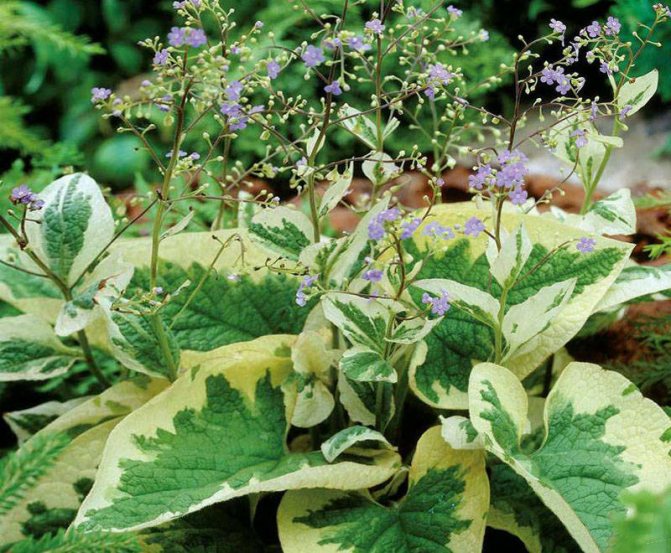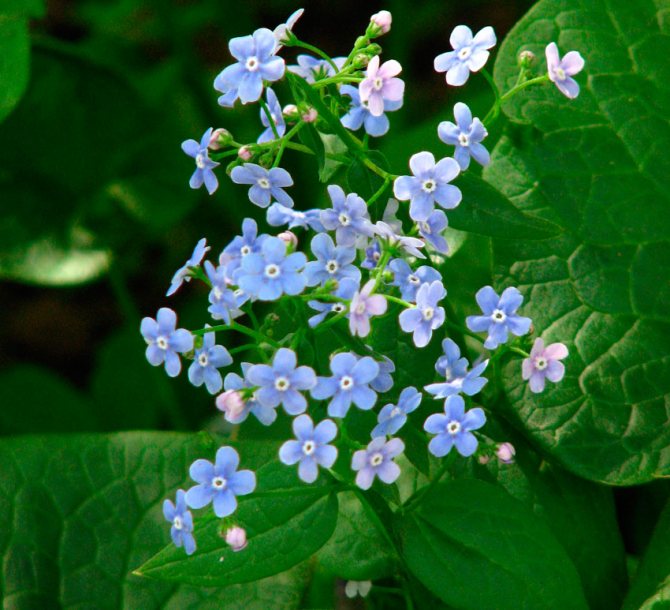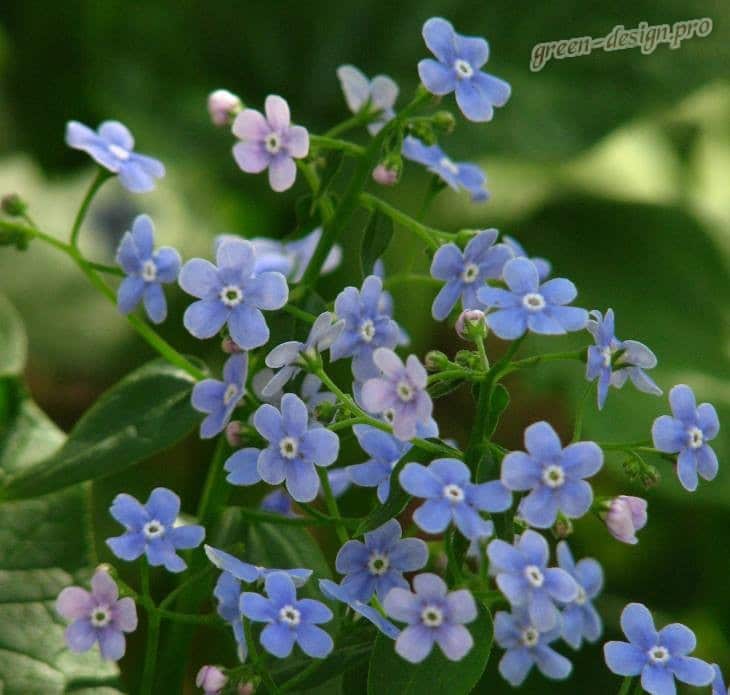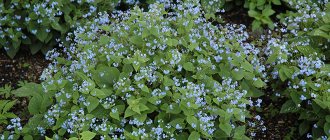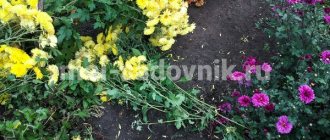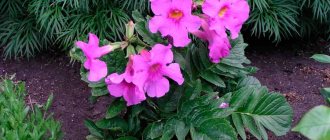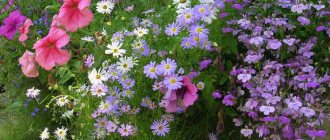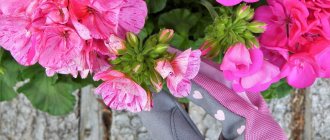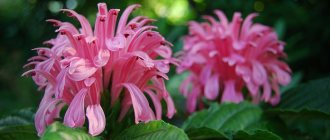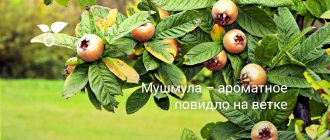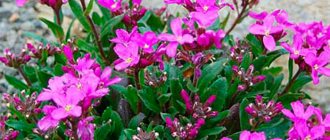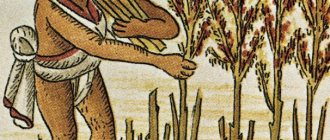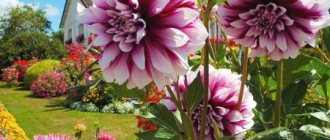Brunner's features
Brunera is a herbaceous plant that is a perennial, a bush in height can reach 45-50 centimeters. There is pubescence on the surface of branchy shoots. Large one-piece long-petiolate leaf plates have a wide-heart shape. Small blue flowers (0.5–1 cm in diameter) are outwardly similar to forget-me-nots, therefore such a plant is also popularly called a forget-me-not. Such flowers are part of paniculate or corymbose inflorescences. Flowering begins in April and lasts 4 weeks, possibly re-flowering in autumn. The flower of this plant differs from forget-me-not in that the spot inside it is painted not yellow, but white. The fruit is a nut. Such an undemanding plant in the care, growing, forms spectacular thickets. It is winter-hardy, but does not feel well during the dry hot period. Bruner can be grown for about 15 years without transplanting in the same place.
Types and varieties
There are only 3 varieties of Brunner in the genus, two of which are found on the territory of Russia. Botanical characteristics:
- Large-leaved... The Caucasus is considered the birthplace of this plant. The shrub can grow up to 40 cm in height and form a powerful rhizome. Stems with strong pubescence, heart-shaped leaves. The most popular type for growing in the garden, since the foliage retains its decorative effect until the first autumn frosts;
- Siberian... It is found wild in Western Siberia. It features a developed root system, as well as the absence of a pronounced bush. Leaves are formed directly from the rhizome. Flowering is possible from the end of May, lasts up to 30 days. Growing requires moderate moisture and regular darkening;
- Eastern... It does not have a high decorative effect, this variety can be found in some countries of the Middle East. Not used in horticulture.
Almost the entire varietal variety was obtained from the large-leaved brunner, since it is this species that has the most beautiful appearance. Varieties differ in bush height, flower color and developmental peculiarities. When choosing, one should take into account the purpose of planting, as well as the climate in the region. Among the most interesting varieties are Jack Frost, Variegata, Silver Hut, Millennium Zilber.
Breeding bruners
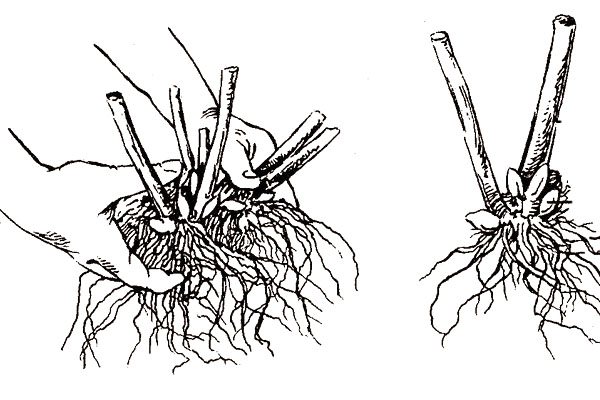
Brunner can be propagated in several ways. All of them are effective if you follow simple rules.
Breeding methods:
- dividing the rhizome;
- sowing seeds;
- in some cases, self-seeding.
The procedure for dividing the rhizome is recommended in August. It is during this period that a flower bud is formed. With successful rooting, brunner will be able to successfully overwinter and bloom next year. It is worth considering that the plant does not tolerate transplants well in the spring. It is possible to change the soil and planting site in spring only for the large-leaved brunner. But in this case, it is necessary to preserve as voluminous earthy lump as possible. This will allow the flower to take root faster.
Brunner's large-leaved has an insufficiently long rhizome, so it is propagated by dividing the bush itself. Each division should have an intact bud and a small area of the rhizome. Such a specimen is planted in a flower garden, in a specially prepared place.
In the Siberian brunner, the rhizome has a branched shape, so the plant should be propagated by segments of the rhizome. Most often, a bush is dug up and divided into small elements. Each must also have a renewal kidney. The section is planted to a depth of no more than three centimeters, and then covered with earth.
Breeding brunner
Brunner reproduces vegetatively (by dividing the bush) and seeds. A favorable time for planting and transplanting comes after the end of the flowering period, that is, in August. By this time, the laying of future shoots just ends. If it is necessary to plant a bush earlier, then it should be dug out with a large margin and transported without sprinkling an earthen lump.
Seed propagation is a more painstaking job, since self-seeding is rare. The seeds ripen around the end of July. For normal germination, they need stratification within 3-4 months, so Brunner must sow before winter.
Brunner's landing
Such a plant in natural conditions prefers to grow in the forest, in this regard, it is shade and moisture-loving. When choosing a site for planting, be sure to take this into account. In hot areas, it is necessary to choose a shaded area for planting bruners, since the scorching sun rays can destroy it. In areas with a less hot climate, planting this flower should be done in a slightly shaded place, or you need to choose an area that will be in the shade after lunch. If you plant it next to a pond, then such a plant is able to withstand the direct rays of the sun. Clayy wet soil is suitable for planting, while the Siberian brunner is more demanding on the composition of the soil than the large-leaved one. Disembarkation, as well as transplantation, are carried out in the last days of July or in the first days of August. Bruner's spring transplant is very poorly tolerated. At this time, only large-leaved bruners can be transplanted, while it is necessary to take an earthen lump of a relatively large size. Disembarkation should be made in the evening or on a cloudy day.
How to plant correctly
Most often, the planting of large-leaved brunners is combined with the division of the flower. After the bush has faded, it must be dug up. Then the root system must be freed from the soil, while immersing it in a container of water. After that, the bush is divided into parts, while adhering to the natural collapse of the rhizome. If necessary, a very sharp, pre-sterilized knife should be used to cut the rhizome. When dividing, it should be borne in mind that roots should be present on each division, as well as a recovery bud of the next year. Plant the cuttings in the holes, and then water them well.
Brunner Siberian can be propagated by segments of rhizomes. It is located very close to the ground surface. From the excavated rhizome, it is necessary to cut out old areas, as well as those on which there is rot. Then it is divided by breaking in such a way that on each resulting cut there is a living bud of renewal. The length of the cut can vary from 4 to 6 centimeters. Each piece is planted separately, buried in the soil by 2-3 centimeters, then it is watered very well.
When the plants are planted, the surface of the soil is sprinkled with a layer of mulch (limestone, sawdust, tree bark, wood ash or coffee grounds).
Plant description
Brunner is a blooming perennial of the Buranchikov family. It has the form of a small herbaceous shrub, growing up to 60 cm. The leaves are represented by heart-shaped plates, usually they are planted on high petioles with pronounced pubescence. Small blue flowers reach a diameter of up to 10 cm, collected in corymbose or paniculate inflorescences. Budding is possible from the second half of April, some varieties show a second flowering in autumn. The fruit is a nut, the plant is capable of self-seeding.
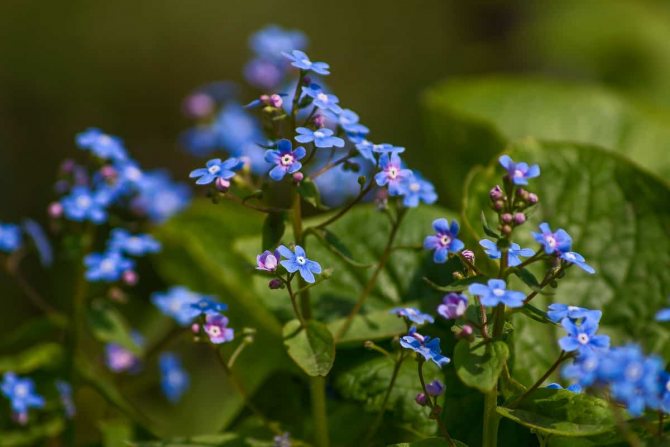

In nature, it occurs next to water bodies, prefers wet meadows near lakes and rivers. In horticulture, it is used for planting in ridges, landscaping borders and the formation of group compositions. Brunner has a high winter hardiness, but does not tolerate drought and prolonged heat. It can grow in one place for up to 15 years.
Brunner's care in the garden
The rules for caring for the Siberian Brunner and the Large-leaved Brunner are different. The large-leaved brunner retains an attractive appearance throughout the growing season, and if you choose the right place for it (shaded with wet soil) when planting, then you can forget about leaving it until autumn time. All that this species will need is systematic weeding, which must be carried out without fail, but it should be borne in mind that it is impossible to loosen the soil, because the root system of the plant is located very close to the soil surface.
After the Siberian brunner has faded, brownish specks will begin to form on its leaf plates. Then the leaves will begin to fade, and it is recommended to remove them in the middle of summer. In the second half of August, young leaves should grow in the Brunner, which can hold out until the first frost. This species is not afraid of weeds, it also does not need watering (there is enough natural precipitation) and loosening of the soil, because the root system is also located quite close to the soil surface. If the summer is very hot, then the Brunners, regardless of the type, will need to be watered periodically, immediately after the leaves begin to droop.
Breeding brunner
The above describes in detail how to propagate brunner by dividing the rhizome. It should be borne in mind that variegated forms can be propagated only in this way. It is quite possible to grow a species brunner from seeds, however, due to early frosts, it rarely has time to set seeds. But you can always get the seeds of such a plant in a specialty store. The seeds of this flower are very small. It is recommended to sow them in open ground before winter (in autumn). For spring sowing, the seeds must be prepared, for this they must be stratified, which lasts 3 or 4 months. To do this, they can be sown in a box and then buried in the snow outside, but the easiest way is to put them on a refrigerator shelf. It should be borne in mind that it is much easier to propagate a Brunner by division than by seeds, and it often reproduces itself by self-seeding.
Pests and diseases
If there is a lot of rain in the summer, then such a plant may develop brown spotting, the spots that have appeared on the leaf plates will testify to the infection. Brunera can also become infected with powdery mildew. In a diseased specimen, all infected parts must be removed, and then it must be treated with any fungicidal agent (for example, Bordeaux mixture).
Whiteflies and aphids can also settle on this flower. To destroy them, it is recommended to process the bush with Karbofos or Aktellik.
Planting and leaving
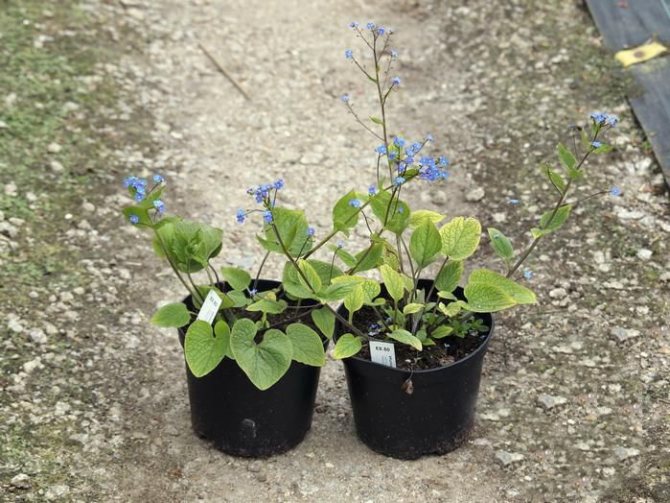

Brunner large-leaved planting and care photo
Brunner naturally grows in woodlands, therefore it perfectly tolerates shady places. Sun exposure is permissible only for a short time, the open sun causes oppression and death of the plant. You can place the brunner in an open place only near a reservoir. In hot regions, constant shade is preferable. The openwork partial shade of fruit trees is ideal for placing a brunner.
- The soil for planting Siberian Brunner should be clayey, heavy, moist.
- Brunner large-leaved prefers looser, fertile soil. In one place, both species can grow without transplanting for more than 15 years and longer.
- Prefers feeding with organic fertilizers.For this, an infusion of mullein is prepared - they are fed once a month.
- You can mulch the plantings with humus in the fall so that in the spring, when the snow melts, the roots receive enough nutrients.
The rhizomes of the plant are intertwined in moist soil and prevent the germination of other plants among themselves. Therefore, weeding is necessary only during transplantation and reproduction, until the young specimens have gained power. Brunner's roots are located almost on the surface, so loosening is not carried out so as not to damage them. The plantings should be mulched with humus so that moisture remains in the soil longer.
Brunner distillation possible
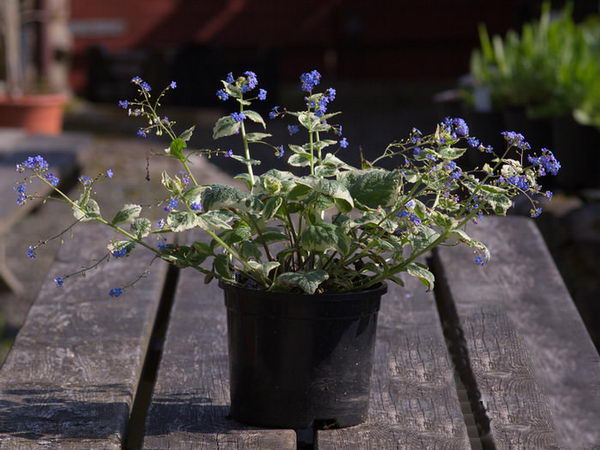

Brunner variegata brunnera macrophylla variegata distillation photo
- To do this, carefully dig out the rhizome with a lump of earth, transfer it into a large flowerpot with drainage holes, filled with a nutritious substrate.
- Before the onset of cold weather, you can leave the plant outdoors so that it adapts faster.
- Then he is transferred to a cool room. The earth is kept moist, preventing overflow.
- In good lighting, the brunner quickly starts to grow - to accelerate flowering, it can be brought into a warmer room.
- The flower arrows will appear by mid-December. By experimenting with the temperature of the content, you can achieve flowering for the New Year or other holidays.
Great for mixborders, borders as a background plant. Brunner is self-sufficient in single plantings on lawns, flower beds, borders.
Planting
The best soil option is considered to be loamy and moist. Seating and replanting takes place in July - August. Spring planting is dangerous for the plant: during this period it is especially sensitive to diseases. Transplanting in the spring is allowed only for a large-leaved forget-me-not, and together with a large lump of soil. Even the weather plays an important role in this process: it is best to take a flower if you transplant it on a gloomy day or in the evening.
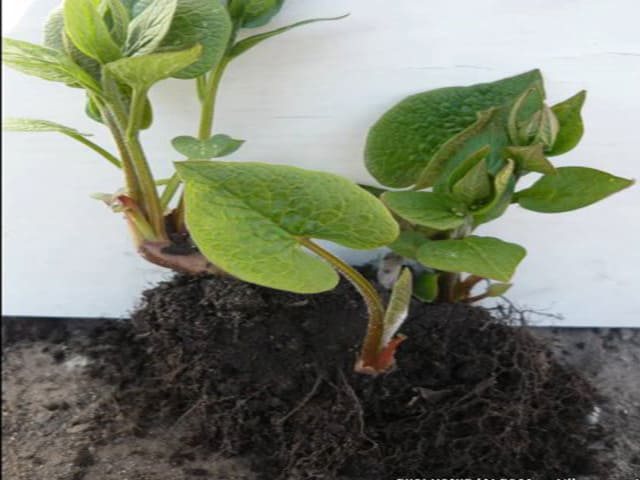

Forget-plant is in harmony in a mixed flower garden with juniper, fern, horned goat weed, wild garlic, which are combined in size and agrarian specifics with delicate blue flowers and green leaves. Landscaping requires the ability to correctly place accents and create a measured transition. Here you need to pay attention:
- to combine short and tall;
- to combine the brightness and variegation of colors, monochromatic groups;
- to take into account the time of flowering and wilting of individual groups.
The proximity to the delphinium allows the forget-me-not to cover the loss of decorativeness in a faded cut plant.
Brunera large-leaved and forget-me-not, are there any differences?
This type of bruner grows mainly in the Caucasus mountains, so local people call it “Caucasian forget-me-not”. Outwardly, it is a small, up to 40 centimeters in height, spreading bush with leafy, rough stems.
Read also: Care, planting and reproduction at home hippeastrum
Bruner leaves reach 25 centimeters in length, they have an oblong shape with a heart-shaped base and a pointed tip.
The size of bruner flowers is about half a centimeter. They are dark blue in color and grow in paniculate corymbose inflorescences.
Despite the fact that Bruner is often confused with forget-me-not, there is a significant difference between their flowers - there is a white spot in the center of the bruner flower, and yellow for forget-me-not.
The flowering of this plant can occur a second time in warm shade. Bruner seeds ripen in July.
Features of the correct transplant of irises.
Badan photo, see here.
Site selection and suitable soil for Brunner
The plant is very suitable for an area that is illuminated by the sun in the morning, but in the shade in the afternoon.
In a completely shaded place, the shoots are stretched out, and the flowers appear sparsely and sparsely.
A completely sunny place is not suitable due to lack of moisture, unless the close location of the garden reservoir will save the situation.
On loams, Brunner grows without special care, additional watering and the introduction of nutrients. It is not necessary to fertilize good garden soil; compost is additionally embedded in the poor soil during the preparation of the site.
However, the introduction of fertilizers into fatty soil, especially fresh manure, often turns out to be an unsuccessful service for the flower - the foliage grows actively and for a long time, but the root system remains poorly prepared for wintering.
This is not scary for a species specimen, it is more stable and tenacious, and varietal bushes often die.
Pests and diseases
Brunner gets sick infrequently. In a rainy summer, the forget-me-not is not too resistant to diseases and can be affected by brown spot, which will be indicated by the appearance of rusty marks on the leaves. In cool and dank seasons, the flower is susceptible to infection by the traditional enemy of shade and moisture-loving plants - powdery mildew. Having noticed the signs of the disease, it is necessary to destroy all diseased elements and spray the plant with a special preparation - Bordeaux liquid. Planted in excessively damp soil or in a container may also rot.
Whiteflies and aphids are considered dangerous pests. To get rid of them, you should treat the bush with karbofos or actellik - broad-spectrum insecticides. In general, plants do not attract pests too much. The roots seduce mice while poisoning them at the same time. This is why a garden planted with a forget-me-not plant is considered rodent-proof.
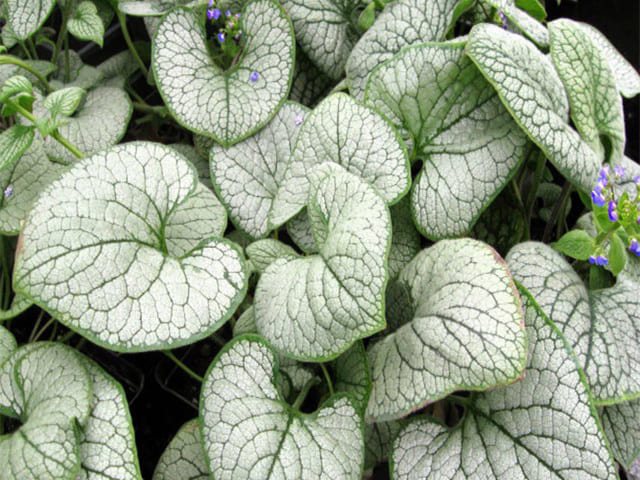

Reproduction, care, disease


The blue-eyed beauty reproduces by dividing a bush or planting seeds. It is better to transplant in August or September, then the root system does not have time to dry out. If, according to the state of the plant, it has to be divided in the spring, then young seedlings are protected from the heat in the summer, covering them with coniferous branches or a special shelter. The seeds are bought or harvested on their own from the fruits. They are planted shortly before winter to accelerate their growth and shelter from the external environment. A full-fledged plant from seeds is obtained in 2-3 years.
Plant care is easy and not time-consuming. For this, it is important to choose a site for planting, take into account external factors (shade, humidity, neighborhood, etc.). The plant does not tolerate direct sunlight. The ideal area is where the sun shines in the first half of the day, and the so-called lace shadow descends in the second half. In too dark places, Brunner loses its decor. Preparing for winter involves pruning at the very root. New shoots appear almost immediately after the snow melts.
The plant is most susceptible to diseases and pests in the spring. That is why it is advisable not to replant it at this time of the year. In order not to damage the root system of the plant, it is impossible to loosen the soil under it. In the rainy season, Brunner is exposed to fungal infections. For example powdery mildew or brown spot. The affected leaves and branches are removed, and the remaining parts of the plant are treated with a solution of chemicals. As a prophylaxis against aphids, a solution of tar soap is used.
Selection
Brunner Variegata, which was one of the first to be created, has decorative cream-colored specks on the leaves. On one bush, milk-cream and light green leaves with a yellowish stripe along the edge grow synchronously. The absence of chlorophyll affects them negatively, causing the formation of dark blots.
The variety was considered not too winning, which is why the growers were looking for a remedy for the situation. More recently, it was possible to bring out a new amazing species, called Jack Frost, which has become an adornment of flower beds for three seasons - from early spring to late autumn.
A half-meter bush with silvery leaves, marked with green veins and dark edging around the edges, looks like a very elegant bright spot on the lawn.It is recommended to combine this variety with neighbors of any green shades, but not variegated, for example, with ferns, the background of which allows the Brunner to look much brighter.
Brunner's Jack Frost perfectly wintering in the central regions of Russia. Reproduction takes place by means of seeds, by dividing the bushes. Success with this variety inspired the breeders to continue their work, resulting in 2 more species: Looking Glass and Silver Wings, whose name translates as "silver wings".
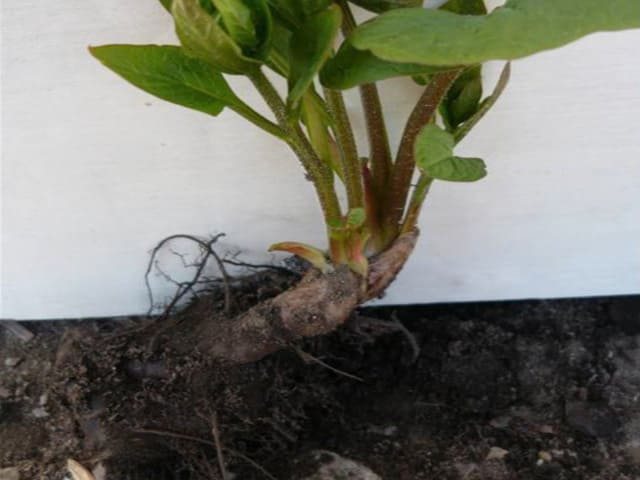

It features wing-like sweeping silvery strokes against a light green background at the edges of the sheets. With the goal of enhancing the decorativeness of the leaves, the breeders had to sacrifice the size of the flowers - they became even smaller.
But in the inflorescence, their number has increased, which gives the plant weightlessness. A feature of Hudspan Cream is a narrow strip of creamy white along the edges of the cupped leaves. In sunlit areas, they can be almost white. Aging foliage causes them to darken to brown, which forces them to get rid of.
Brunner large-leaved, Siberian and other species
The site is chosen based on the characteristics of the variety. Brunner is unpretentious to the level of humidity. Through this plant, the shady corners of the garden are ennobled.
| Variety | Description | Leaves | Flowers |
| Large-leaved (brunnera macrophylla) | Pubescent stems. The height of the plant is 50 cm. The homeland of this culture is the Caucasus. | Heart-shaped, rough underside. | The diameter is about 7 mm. Apical inflorescences. If all conditions are met, they can bloom again. |
| Siberian (brunnera sibírica) | Large size, the height of the thickets is 60 cm. | Located at the root, characterized by a dense structure and wrinkled surface. | The diameter of the dark blue corollas is 5 mm. Paniculate inflorescences bloom for several weeks. |
| Eastern (brunnera orientalis) | Stunted, resistant to weather conditions. | Elliptical, length - 10 cm. | Nondescript corollas that look like forget-me-nots. |


Large-leaved Brunner varieties
The perennial plant grows rapidly in the shade. Shrubs, even after flowering, retain their decorative appearance. Silvery leaves are decorated with a bright border, green veins and blotches of a lighter shade.
The horizontal rhizome consists of thickened and filamentous appendages. The length of the petioles depends on the size of the leaf blades. The height of the erect stem is 60 cm.
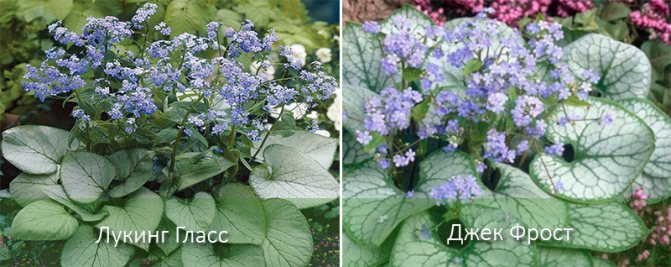

Shoots are pubescent over the entire surface. Peduncles emerge from the axils located at the apical leaf blades.
The general list includes:
| Variety | Leaves |
| Millennium Zilber | Decorated with silvery spots. |
| Jack Frost | White, narrow border along the edge. |
| Langtries | Dark green, speckled. Bluish inflorescences. |
| Silver Wings | Carved, covered with silvery cobwebs. |
| Looking Glass | Olive-silvery, decorated with threadlike veins. Pale blue corollas. |
| Kings Ransom | Silvery, characterized by a dense structure. Among the distinctive features are a wide milky border, an elegant ornate pattern. |
| Variegata | The middle is bright green, the flowers are pale pink, there is no aroma. |
| Hudspan Cream | Wide, heart-shaped, no more than 15 cm long, pale pinkish border. |
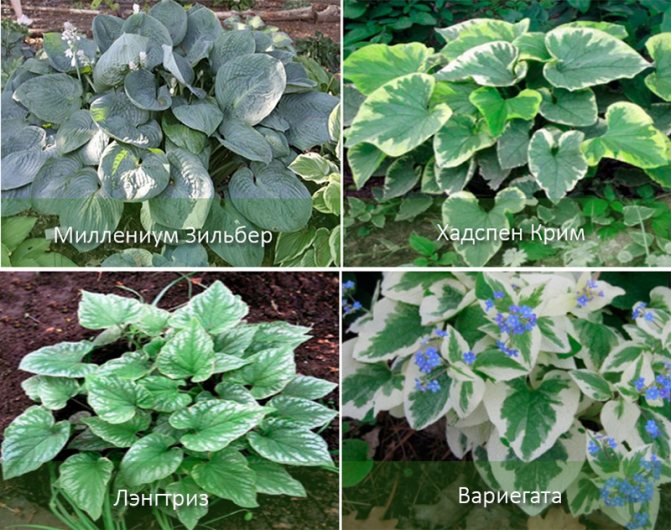

Forget-me-not in landscape design
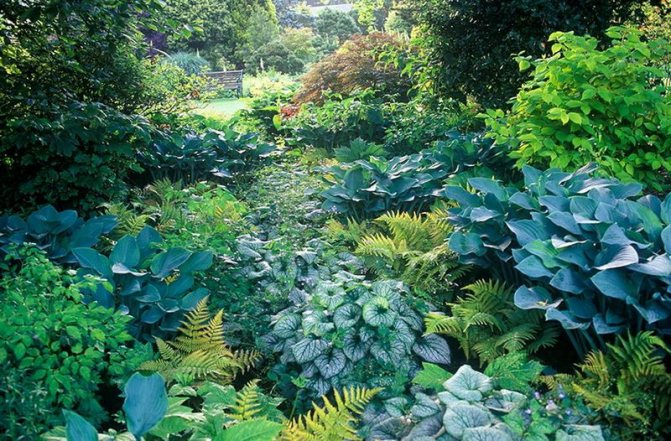

Brunner in landscape design photo mixborder
Brunner is suitable for decorating shady, damp areas. It grows rapidly and does not require either physical or financial costs. At one time, in the courtyards of many institutions, hospitals, schools, kindergartens, one could find brunner thickets on the north side of buildings, in shady places of sites where other plants simply would not survive in these conditions.
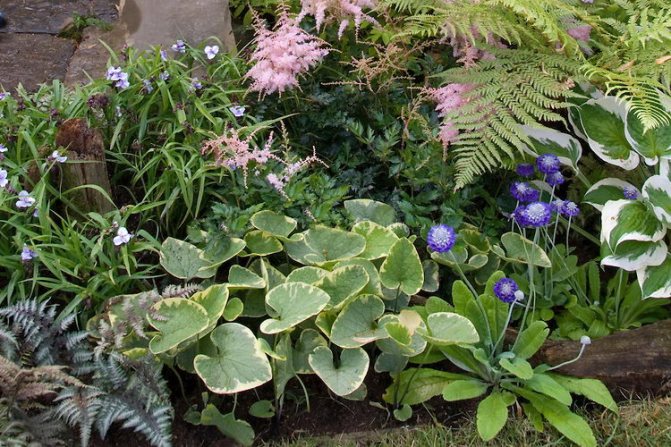

Brunner's garden landscaping photo with other plants Brunnera ‘Hadspen Cream’ with Hosta, ferns, Astilbe, Athyrium nipponicum var pictum
And Brunner grows, filling free space with pleasure.She perfectly coped with the task of landscaping unsightly places on the territory and did not require any care, growing naturally in the most suitable place for her.
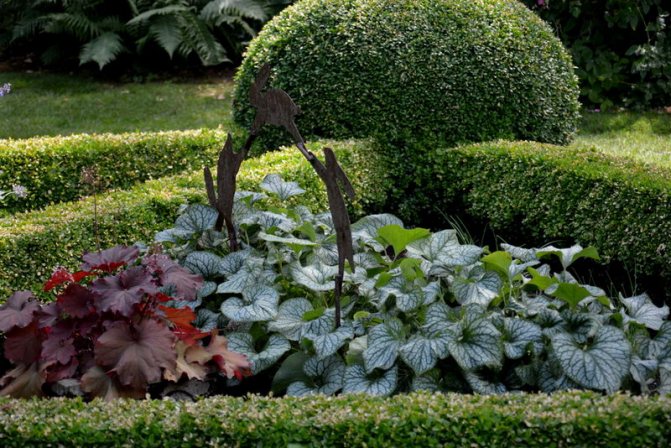

Brunner macrophile in landscape design photo
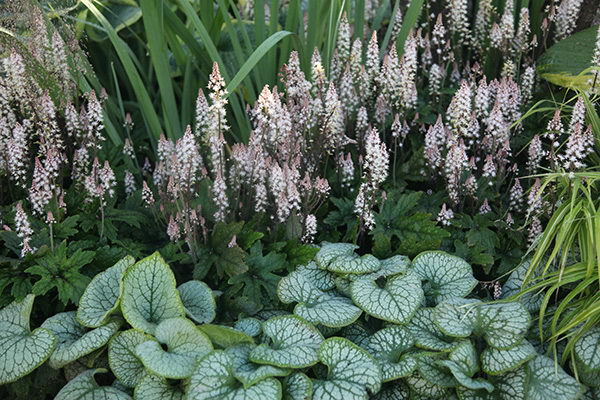

Brunner in combination with tiarella photo mixborder Tiarella & Brunnera
Description of brunner or forget-me-not
Brunner (Brunnera) - herbaceous perennial 45-55 cm high belongs to the Burachnikov family, whose homeland are taiga forests, the banks of rivers and streams of Siberia and Asia Minor. The rhizome is thick, long, with several branched stems. Pubescent large cordate leaves sit on long petioles. Flowers are collected in paniculate inflorescences. The fruit is a dry nut, which, when ripe, breaks down into several parts. Small, few ripen by the end of summer.

